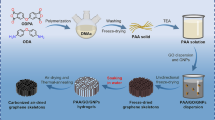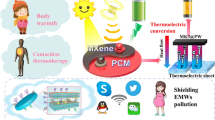Abstract
In this study, the effects of Janus, hydrophilic and hydrophobic hollow graphene oxide (HO) particles on the thermal conductivity of binary polymer blends were investigated. The HO Janus (HOJ) micro- and nanoparticles were synthesized via buoyancy-induced desymmetrization process. The characteristics of the produced HO and HOJ micro- and nanoparticles were investigated using FTIR, TGA, EDX, FE-SEM, centrifuge and contact angle tests. Different PS/PMMA micro- and nanocomposite samples were prepared via solution mixing and subjected to the thermal conduction test. The results revealed that the presence of HO micro- and nanoparticles in either phase could increase the conduction coefficient of the PS/PMMA blend (K) though their simultaneous presence in both phases had significantly more impact on K. On the other hand, comparing the results of the blend samples with and without HOJ micro- and nanoparticle defined an outstanding improvement in the thermal conductivity of the polymer/polymer interface due to the presence of Janus particles. Also, the thermal stability of the samples decreased with the increment of their thermal conductivity and this effect was more significant in the case of the samples containing both HO and HOJ micro- and nanoparticles.
Graphical abstract











Similar content being viewed by others
References
Candlin JP (2008) in Chalmers JM, Meier RJ (eds) Comprehensive Analytical ChemistryElsevier, Hungary
Nayak SK, Mohanty S, Unnikrishnan L (2017) Trends and applications in advanced polymeric materials. Wiley, Hoboken
Subramanian MN (2017) Polymer blends and composites: chemistry and technology. Wiley, Beverly
H-G Elias (1984) Macromolecules: Volume 2: Synthesis, materials, and technology, Springer, Boston
de Souza JP, Baird DG (1996) In situ composites based on blends of a poly(ether imide) and thermotropic liquid crystalline polymers under injection moulding conditions. Polymer 37:1985. https://doi.org/10.1016/0032-3861(96)87317-4
Sharifzadeh E, Amiri Y (2020) The effects of the arrangement of Janus nanoparticles on the tensile strength of blend-based polymer nanocomposites. Polym Compos 41:3585. https://doi.org/10.1002/pc.25645
Sharifzadeh E (2019) Modeling of the mechanical properties of blend based polymer nanocomposites considering the effects of Janus nanoparticles on polymer/polymer interface. Chin J Polym Sci 37:164. https://doi.org/10.1007/s10118-019-2178-3
Sharifzadeh E, Ghasemi I, Qarebagh AN (2015) Modeling of blend-based polymer nanocomposites using a knotted approximation of Young’s modulus. Iran Polym J 24:1039. https://doi.org/10.1007/s13726-015-0391-7
Kim G-H, Lee D, Shanker A et al (2015) High thermal conductivity in amorphous polymer blends by engineered interchain interactions. Nat Mater 14:295. https://doi.org/10.1038/nmat4141
Liu J, Cai C, Wang Y et al (2020) A biomimetic plasmonic nanoreactor for reliable metabolite detection. Adv Sc 7:1903730. https://doi.org/10.1002/advs.201903730
Li A, Zhang C, Zhang Y-F (2017) Thermal conductivity of graphene-polymer composites: mechanisms, properties, and applications. Polymers 9:437
John V (1992) Introduction to engineering materials. Palgrave Macmillan, London
Cheng W, Zhang J, Liu J, Yu Z (2020) Granular hydrogels for 3D bioprinting applications. VIEW 1:20200060. https://doi.org/10.1002/VIW.20200060
Denn MM (2008) Polymer melt processing: foundations in fluid mechanics and heat transfer. Cambridge University Press, Cambridge
Sogolova TI, Demina MI (1977) Temperature dependence of the mechanical properties of polymers of different chemical structure in the temperature range from 4.2 to 300°K. Polym Mech 13:333. https://doi.org/10.1007/BF00859411
Moreira DC, Sphaier LA, Reis JML, Nunes LCS (2011) Experimental investigation of heat conduction in polyester–Al2O3 and polyester–CuO nanocomposites. Exp Therm Fluid Sci 35:1458. https://doi.org/10.1016/j.expthermflusci.2011.06.004
Shang L, Wang Y, Cai L, Shu Y, Zhao Y (2020) Structural color barcodes for biodiagnostics. View 1:e8. https://doi.org/10.1002/viw2.8
Bai Y, Keller T, Vallée T (2008) Modeling of stiffness of FRP composites under elevated and high temperatures. Compos Sci Technol 68:3099. https://doi.org/10.1016/j.compscitech.2008.07.005
Dutta PK, Hui D (2000) Creep rupture of a GFRP composite at elevated temperatures. Comput Struct 76:153. https://doi.org/10.1016/S0045-7949(99)00176-5
Liang JZ, Li FH (2007) Heat transfer in polymer composites filled with inorganic hollow micro-spheres: a theoretical model. Polym Test 26:1025. https://doi.org/10.1016/j.polymertesting.2007.07.002
Sun S, Wang R, Huang Y et al (2019) Design of hierarchical beads for efficient label-free cell capture. Small 15:1902441. https://doi.org/10.1002/smll.201902441
Tanaka K, Ogata S, Kobayashi R, Tamura T, Kitsunezuka M, Shinma A (2013) Enhanced heat transfer through filler-polymer interface by surface-coupling agent in heat-dissipation material: a non-equilibrium molecular dynamics study. J Appl Phys 114:193512. https://doi.org/10.1063/1.4831946
Hida S, Hori T, Shiga T, Elliott J, Shiomi J (2013) Thermal resistance and phonon scattering at the interface between carbon nanotube and amorphous polyethylene. Int J Heat Mass Transfer 67:1024. https://doi.org/10.1016/j.ijheatmasstransfer.2013.08.068
Sharifzadeh E, Salami-Kalajahi M, Hosseini MS, Aghjeh MKR (2017) Synthesis of silica Janus nanoparticles by buoyancy effect-induced desymmetrization process and their placement at the PS/PMMA interface. Colloid Polym Sci 295:25. https://doi.org/10.1007/s00396-016-3977-5
Cardinaels R (2020) in A.R A, Thomas S (eds) Compatibilization of Polymer Blends, Elsevier, Amsterdam, Netherland
Sharifzadeh E (2021) Evaluating the dependency of polymer/particle interphase thickness to the nanoparticles content, aggregation/agglomeration factor and type of the exerted driving force. Iran Polym J. https://doi.org/10.1007/s13726-021-00956-3
Sharifzadeh E, Cheraghi K (2021) Temperature-affected mechanical properties of polymer nanocomposites from glassy-state to glass transition temperature. Mech Mater 160:103990. https://doi.org/10.1016/j.mechmat.2021.103990
Su H, Hurd Price CA, Jing L, Tian Q, Liu J, Qian K (2019) Janus particles: design, preparation, and biomedical applications. Mater Today Bio 4:100033. https://doi.org/10.1016/j.mtbio.2019.100033
Marschelke C, Fery A, Synytska A (2020) Janus particles: from concepts to environmentally friendly materials and sustainable applications. Colloid Polym Sci 298:841. https://doi.org/10.1007/s00396-020-04601-y
Su H, Liu T, Huang L et al (2018) Plasmonic Janus hybrids for the detection of small metabolites. J Mater Chem B 6:7280. https://doi.org/10.1039/C8TB01587B
Sharifzadeh E, Salami-Kalajahi M, Hosseini MS, Aghjeh MKR (2016) A temperature-controlled method to produce Janus nanoparticles using high internal interface systems: experimental and theoretical approaches. Coll Surf A 506:56. https://doi.org/10.1016/j.colsurfa.2016.06.006
Zamanian-Fard A, Sharifzadeh E, Rajabi L (2020) A spontaneous interfacial process to produce silica Janus nanosheets as perfect emulsifiers in pickering emulsions. J Dispers Sci Technol. https://doi.org/10.1080/01932691.2020.1848575
Sharifzadeh E, Parsnasab M (2021) Direct and reverse desymmetrization process in O/W Pickering emulsions to produce hollow graphene oxide Janus micro/nano-particles. Coll Surf A 619:126522. https://doi.org/10.1016/j.colsurfa.2021.126522
Zhang Y, Jia F, Tang L et al (2019) Particle mold synthesis of block copolymer janus nanomaterials. Macromol Rapid Commun 40:1900067. https://doi.org/10.1002/marc.201900067
Correia EL, Brown N, Razavi S (2021) Janus particles at fluid interfaces: stability and interfacial rheology. Nanomaterials 11:374
Lim KH, Wong KW, Cadavid D et al (2019) Mechanistic study of energy dependent scattering and hole-phonon interaction at hybrid polymer composite interfaces for optimized thermoelectric performance. Compos B Eng 164:54. https://doi.org/10.1016/j.compositesb.2018.11.059
Cao J, Wang Y, Xiao P et al (2013) Hollow graphene spheres self-assembled from graphene oxide sheets by a one-step hydrothermal process. Carbon 56:389. https://doi.org/10.1016/j.carbon.2012.12.075
Perro A, Meunier F, Schmitt V, Ravaine S (2009) Production of large quantities of “Janus” nanoparticles using wax-in-water emulsions. Coll Surf A 332:57. https://doi.org/10.1016/j.colsurfa.2008.08.027
Hong L, Jiang S, Granick S (2006) Simple method to produce janus colloidal particles in large quantity. Langmuir 22:9495. https://doi.org/10.1021/la062716z
Sharifzadeh E, Salami-Kalajahi M, Salami Hosseini M et al (2017) Defining the characteristics of spherical Janus particles by investigating the behavior of their corresponding particles at the oil/water interface in a Pickering emulsion. J Dispers Sci Technol 38:985. https://doi.org/10.1080/01932691.2016.1216861
Socrates G (2004) Infrared and Raman characteristic group frequencies: tables and charts. Wiley
Alghunaim A, Brink ET, Newby B-MZ (2016) Surface immobilization of thermo-responsive poly(N-isopropylacrylamide) by simple entrapment in a 3-aminopropyltriethoxysilane network. Polymer 101:139. https://doi.org/10.1016/j.polymer.2016.08.059
Valencia C, Valencia CH, Zuluaga F, Valencia ME, Mina JH, Grande-Tovar CD (2018) Synthesis and application of scaffolds of chitosan-graphene oxide by the freeze-drying method for tissue regeneration. Molecules 23:2651
Giermanska-Kahn J, Laine V, Arditty S, Schmitt V, Leal-Calderon F (2005) Particle-stabilized emulsions comprised of solid droplets. Langmuir 21:4316. https://doi.org/10.1021/la0501177
Wang Y, He Q, Qu H et al (2014) Magnetic graphene oxide nanocomposites: nanoparticles growth mechanism and property analysis. J Mater Chem C 2:9478. https://doi.org/10.1039/C4TC01351D
McKeen LW (2017) in McKeen LW (ed) Film properties of plastics and elastomers (Fourth Edition)william andrew publishing, Waltham, USA
Visakh PM, Arao Y (2015) Thermal degradation of polymer blends, composites and nanocomposites. Springer International Publishing, Switzerland
Author information
Authors and Affiliations
Contributions
ES contributed to supervision, project administration, writing (review and editing)—visualization, investigation, validation, conceptualization, methodology. EP contributed to methodology, investigation, writing (original draft)—visualization, resources, formula analysis.
Corresponding author
Ethics declarations
Conflict of interest
The authors declare that they have no conflicts of interest.
Additional information
Handling Editor: Jaime Grunlan.
Publisher's Note
Springer Nature remains neutral with regard to jurisdictional claims in published maps and institutional affiliations.
Supplementary Information
Below is the link to the electronic supplementary material.
Rights and permissions
About this article
Cite this article
Pourakbar, E., Sharifzadeh, E. Synthesis of Janus/non-Janus hollow graphene oxide micro- and nanoparticles and the effects of their localization on the thermal conductivity of blend-based polymer composites. J Mater Sci 56, 18078–18092 (2021). https://doi.org/10.1007/s10853-021-06402-2
Received:
Accepted:
Published:
Issue Date:
DOI: https://doi.org/10.1007/s10853-021-06402-2




